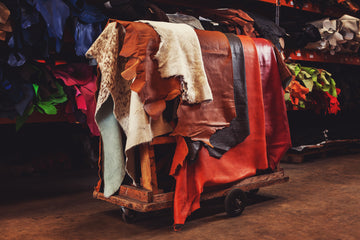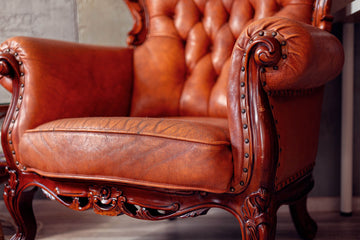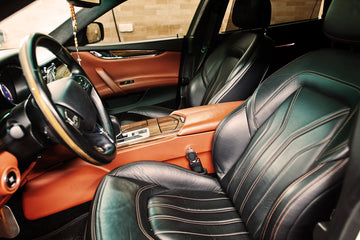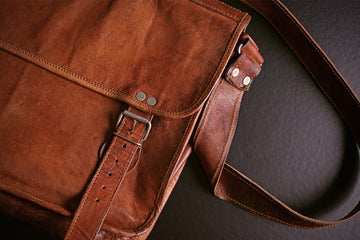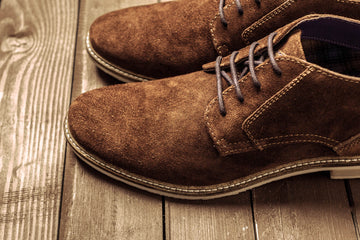Choosing leather furniture is more than a style statement; it shapes your home for years to come. Because leather is usually the most visible and tactile element in any piece, the type you choose enhances everyday enjoyment while securing the item's future value.
The market now brims with leathers, each grade bringing unique strengths and characteristics that influence how long it lasts, its appearance under light, and the level of care it requires. By learning these traits, you can outfit a grand living room, a busy waiting area, or an upscale car cabin with confidence.
The pages that follow break down the top upholstery leathers, covering a range of budgets and quality goals. Examine everything, from premium full-grain hides to cost-effective corrected-grain skins, and demonstrate how grain type, finish style, and additional features suit the task at hand.
Understanding Upholstery Leather Quality
Upholstery leather stands apart from most other hides because it has to meet very particular demands. While leather used for wallets, belts, and similar items mainly focuses on appearance or a smooth feel, chairs and sofas require just the right mix of strength, comfort, and beauty.
To hold up in homes, a good upholstery hide has to shrug off daily bumps yet still feel nice and look rich. Much of that endurance comes from the fibres in its outer layer, which keep everything anchored over the years. Skilful tanning ensures the surface resists stretching, cracking, or tearing, regardless of how often people sit, slide, or lean against it.
Essential upholstery leather characteristics include:
-
Durability for heavy daily use and extended furniture lifespan
-
Flexibility enabling proper shaping around furniture contours without cracking
-
Resistance to abrasion, staining, and fading from regular exposure
-
Comfort maintains pleasant tactile qualities during extended contact
A typical cattle hide offers about forty to sixty square feet of usable surface, and bigger hides mean fewer seams in the final piece. Fewer seams not only look cleaner but also add to the overall strength of the furniture, helping it hold up longer in everyday use.
The Best Leather Types for Upholstery
Leather quality ranks squarely at the centre of performance, look, and price in upholstery work. By sorting hides into clear categories, designers can quickly match a leather type to each job's needs and budget.
Full Grain Leather for Premium Upholstery
Full-grain leather sits at the very top for high-end furniture builders. Because the complete top layer is left intact, only hair and a light rough edge are removed, the strongest fibres are untouched and ready for heavy use.
Notable perks of full-grain leather:
-
Keeps original scars, wrinkles, and grain lines for a genuine, story-filled look.
-
Develops a warm, rich patina with use, imparting a unique signature to each piece over time.
-
Breathes freely through small open pores that never get sealed.
-
Lasts remarkably well when cleaned, conditioned, and kept out of direct sun.
-
Feels plush yet firm, providing that distinctive, inviting touch luxury buyers expect.
Because pure aniline dye shows the hide so plainly, full grain needs more care and is less stain-proof than thicker finishes. Still, its rare beauty makes it sought after for upscale living-room sofas, board-room seating, and premium car interiors.
That very same beauty, however, makes the price steep. Only top-grade hides, graded by size, blemish count, and thickness, are selected for use. Artisans limit machine work to preserve the natural texture of the surface.
Top Grain Leather: The Sweet Spot
Top-grain leather strikes a great compromise between high-end quality and everyday practicality, as its surface is lightly sanded to remove imperfections. Yet, most of its natural texture remains intact. This gentle treatment makes the hide look even while preserving the core strength that leather is famous for.
During production, workers shave off only the very top layer, then buff the hide so that marks are erased but enough original grain remains to give it personality. After that, a clear sealant is often applied, allowing everyday spills to slide off and the material to hold up long-term.
Key advantages of top grain leather:
-
Improved uniformity compared to full grain while retaining natural appeal
-
Enhanced stain and scratch resistance through protective finishing
-
Lower cost than full grain while maintaining high quality standards
-
Versatile performance suitable for both residential and commercial applications
-
Easier maintenance requirements than unprotected leather types
Top-grain leather is the most popular choice for residential leather sofas and dining chairs, offering a luxurious aesthetic with practical durability. The balanced characteristics make it equally suitable for moderate-traffic commercial furniture.
Semi-Aniline Leather for Versatile Applications
Semi-aniline leather charts a course between pure aniline and heavily treated hides by adding a light colour coat over aniline dye, marrying beauty with everyday endurance. The layer steadies shade, doubles up against spills and softens UV attack without hiding the grain.
Thanks to that gentle finish, the leather keeps its hand feel and breathability, yet gains just enough armour for rooms that see steady but not relentless foot traffic. Due to this mix, semi-aniline hides often end up in living room sofas and breakfast chairs, where moderation prevails.
Benefits of semi-aniline finishing:
-
Maintains natural leather feel with improved practicality
-
Offers better colour consistency than pure aniline options
-
Provides enhanced stain resistance without heavy coating
-
Suitable for both residential and upscale commercial applications
-
Requires less intensive maintenance than unprotected leather
Corrected Grain Leather for Budget-Conscious Applications
Corrected grain leather is heavily skived, buffed, and then embossed to conceal any blemishes, resulting in a tidy, uniform surface. A dense pigmented top coat is then applied, supplying both colour consistency and a strong shield against everyday wear.
Although this process strips away many of the natural hallmarks of premium hides, corrected grain still shines in practical settings. Its even look and added toughness make it a budget-friendly option for busy public spaces where durability is more important than untamed beauty.
Practical advantages include:
-
Consistent appearance across large installations
-
Superior stain and wear resistance through heavy finishing
-
Lower cost, enabling broader accessibility
-
Minimal maintenance requirements
-
Suitable for demanding commercial environments
Leather Finishing Options for Upholstery
The way leather is finished determines its performance, the level of care it requires, and its appearance on the shelf or in the home. Finishing sets the barrier between everyday life and the hide's original character, guiding both resilience and visual appeal.
Aniline Finish for Natural Beauty
Aniline leather receives a see-through dye treatment applied from the back, resulting in the softest, most authentic look available. Because the colour seeps instead of sitting on top, every pore, scar, and grain difference shows proudly, delivering that rare, raw beauty connoisseurs adore.
Of course, that honesty comes at a price: Aniline hides soak up spills and oils like a sponge, leaving them vulnerable to unsightly marks. To prevent a disaster, every drip must be wiped away almost immediately, and routine, gentle care must be part of daily life.
Best applications for aniline leather:
-
Low-traffic luxury environments
-
Private offices and formal spaces
-
Carefully controlled residential areas
-
Premium furniture where natural beauty takes priority
Semi-Aniline Finish for Balanced Performance
Semi-aniline leather shares the rich colour of aniline hides but swaps a thin, clear topcoat that softens the texture just enough to guard against spills. Because it retains most of the natural grain visible, it falls between full aniline and pigmented options in terms of feel and appearance, making it the most flexible finish for furniture or trim.
The light seal still allows the hide to breathe, so chairs and sofas stay comfortable, yet it prevents everyday risks from sweaty hands, ink-stained pens, or stray crumbs. That balance suits homes with busy living rooms or light-contract areas where the finish must impress visitors yet shrug off normal wear.
Pigmented Finish for High-Traffic Applications
Pigmented leather comes with a thick, consistent layer of colour and sealant that blocks almost all dents, fades, and stains. While the added surface can mask some of the hide's natural markings, the heavy-duty finish is the industry standard for places that never slow down.
Cleaning remains fast, too-a damp cloth usually does the job-so pigmented hides fit restaurants, hospitals, lobbies, and every other setting where shine and sanitation matter more than every pore showing.
Key Factors When Selecting Upholstery Leather
Selecting the right leather involves considering factors such as appearance, texture, budget, location, and the level of care the piece will receive throughout its lifespan. By sorting through those details, a designer or owner can align a skin's strengths with the exact job at hand and avoid buyer's regret later on.
Heavy-traffic spaces do best with pigmented or semi-aniline top-grain leathers. These hides resist scuffs and stains, so they maintain their appearance even in high-traffic areas, such as busy waiting rooms, family yards, or rental apartments. A soft, supple feel remains intact while the colour layer shields the surface. Commercial lobbies, playroom seating or restaurant booths benefit from that extra durability.
In quieter, controlled areas, true aniline or nubuck leathers are ideal because their natural character and rich patina can truly shine through. Private home offices, formal dining sets, and museum-quality accent pieces often justify a more delicate hide. They still require care, including occasional protective sprays, careful cleaning, and protection from direct sunlight, to maintain their lasting beauty.
Maintenance Requirements and Cleaning Preferences
Not every leather type is the same, so owners must adjust care routines if they want their furniture to look good for years. Aniline and nubuck require prompt action when spills occur and a regular dose of conditioning, whereas pigmented hides respond well to little more than a wipe.
Before settling on leather, owners should consider how much time they can dedicate to upkeep. Professional cleanings, conditioning, and any special tools raise the total cost long after the store receipt is forgotten.
Aesthetic Goals and Design Fit
The look a homeowner hopes to achieve steers the choice of leather, because each grade tells its own visual story. Aniline and semi-aniline skins boast warm colour play and a living patina, while pigmented styles offer even, repeatable tones.
The grain pattern, colour bleed, and how the hide fades or brightens over time must match the room's design plan so that the finished piece meets both functional and aesthetic requirements.
Budget Constraints and Value Expectations
Leather prices vary dramatically based on grade, finishing, and quality standards. Full-grain aniline leather commands a premium price, often double that of corrected-grain alternatives per square foot.
Best Leather Choices by Application
Different environments and furniture types require specific leather characteristics for optimal performance and satisfaction. Matching leather properties with intended use ensures successful upholstery projects.
Commercial High-Traffic Applications
Restaurants, hotels, clinics, and busy offices require surfaces that remain smart and withstand heavy use. Full-finish or deep-pigmented corrected grain hides resist stains, scratches, and fading damage from sunlight, and they wipe clean with straightforward methods.
Large projects look better and perform more reliably when every piece matches in hue and durability. A tough added top coat proves strong against commercial cleaners and daily traffic, remaining clear long after many cleanings.
Residential Living Areas
In homes, designers have more room to choose, and semi-aniline top-grain leather hits the sweet spot for most rooms. It provides the inviting softness people love while still resisting everyday spills and marks.
Sofas in private spaces can reveal their natural grain and slowly develop a warm patina, showing small signs that a family is using them. Buying good leather means spending wisely, since well-kept chairs and couches last years longer and still look fresh.
Luxury and Executive Environments
High-end residential and executive commercial spaces benefit from full-grain aniline leather, where natural beauty and prestige take priority. These controlled environments allow appreciation of leather's finest characteristics while minimising exposure to damaging conditions.
The superior tactile experience and unique natural variation create distinctive environments that reflect quality and attention to detail. Proper maintenance preserves these characteristics for decades.
Automotive Interior Applications
Car interiors require specialised leather processing to withstand temperature extremes, UV exposure, and heavy use. Automotive upholstery typically utilises top-grain semi-aniline or pigmented leathers, which offer enhanced lightfastness and flexibility.
The automotive environment demands leather that maintains appearance and comfort despite challenging conditions, including direct sunlight, temperature fluctuations, and frequent entry/exit stress.
Specialised Commercial Requirements
Healthcare, hospitality, and institutional applications may require additional treatments, including antimicrobial properties, flame retardance, or enhanced cleanability. These specialised requirements often necessitate specific leather types and finishing processes.
Contract furniture specifications frequently mandate particular performance standards that influence leather selection beyond basic quality considerations.
Long-Term Economic Considerations
Genuine leather furniture usually retains its value better than faux pieces, and it feels nicer and looks richer from the start, all the way through. Choosing full- or top-grain hides means buying something designed to last, so the planet benefits too, because you don't need to replace it every few years.
Cheaper bonded-leather sofas or all-man-made coverings may wear out two, even three times, while a single top-quality couch is still in good condition, which makes that pricier piece friendlier to your wallet in the end.
When shopping for upholstery hides, weigh the upfront price against how long you want the piece to last in service; doing so leads to choices that truly pay off over the decades. The ideal hide combines the quality you expect with the performance your home demands, keeping you happy with the purchase far into the future.
